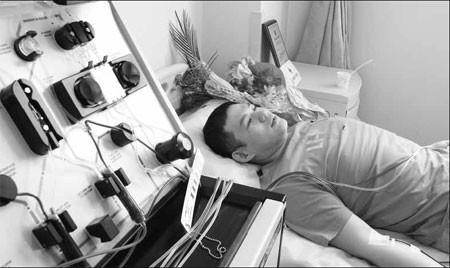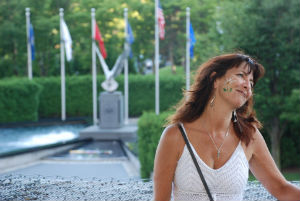Wednesday, May 29, 2013
Saturday, May 11, 2013
| |||||||||||||||||
Thursday, May 9, 2013
Jilin student makes his second stem cell donation to ailing man
Updated: 2013-05-09 08:06
By Ou Hailin in Beijing and Han Junhong in Changchun (China Daily)
| |||||||||

Wang Yuanxiang in Changchun, Jilin province, donates blood stem cells for a 37-year-old leukemia patient on Monday. Wang, a 24-year-old student at the Jilin Institute of Physical Education, has been a regular blood donor for six years. Sheng Xuesong / for China Daily
|
Wang Yuanxiang donated his blood stem cells for a leukemia patient about 1,000 km away on Monday.
It is his second donation in three years to the same patient.
Wang, a 24-year-old college student at Jilin Institute of Physical Education in Northeast China's Jilin province, has been a regular blood donor for six years.
Encouraged by a cousin who is a doctor, Wang had made a habit of donating blood once every six months.
It was his donations of blood that has led to Wang's contact with the China Marrow Donor Program and later his donation of the life-giving cells.
"I was on a blood collection bus when a nurse asked me whether I want to be a marrow donor," Wang said.
"It was 2009, and I had seen basketball star Yao Ming being a marrow donor on TV. I signed up for the program because I believe either donation could help someone."
Two years later, Wang was told he was a match for a man dying of leukemia.
"When I informed (Wang) and asked whether he still wanted to donate, he said, 'I keep my word,' " said Yu Li, a staff member at the Jilin branch of the China Marrow Donor Program, which is under the Red Cross Society of China.
Yu had also asked the young man, then a 22-year-old junior, to inform his family and university about his donation. It was while school was in session, and once the matching process started, the recipient will shoulder all the costs involved, which could be massive and yet in vain if the donor gives up halfway through the process.
But Wang did not tell anyone, a strategy he abandoned for his second donation.
It took him 10 days away from school to complete the donation process, which included the physical examination, hospital admission and the collection of the stem cells.
When he returned from the hospital, however, Wang was nearly punished by the school for his absence from class, until a thank-you letter from the recipient came to his rescue and helped him explain everything.
This March, Wang was told that the patient who had received his blood stem cells needed a second marrow transplant, and he was the only match that the CMDP could find.
Like the first time, Wang did not hesitate to say yes.
"I told my family and my doctor cousin about the donation. At first they didn't agree. But I insisted that if I did not donate this time, then my first donation would be meaningless," Wang said.
"And I told them, 'I am a man now who can take the responsibility for what I have done,' " he said. He finally persuaded his family to allow his second donation.
The process of his second donation on Monday was shorter than the first, since first-time donors have to take a drug for six days to stimulate the formation of new blood cells.
"You don't have to be anesthetized," Wang referring to the collection of the stem cells from the blood.
"The doctor hooks you up to a machine that extracts the stem cells from your blood and returns all the rest of your blood to your body.
"The only thing that troubled me was that I had to stay in the same position for three hours," Wang said.
Contact the writers at ouhailin@chinadaily.com.cn and hanjunhong@chinadaily.com.cn
(China Daily 05/09/2013 page4)
Tuesday, May 7, 2013
Stem cell research provides hope for epilepsy cure
2 8 10 0 Google +0
Researchers from UC San Francisco have discovered a way to reverse severe forms of epilepsy in mice with stem cells, providing a new sense of hope for patients who suffer from the seizure-inducing disorder.
Published earlier this month in Nature Neuroscience, the UCSF study demonstrated that transplantation of medial ganglionic eminence (MGE) cells, embryonic neurons that can inhibit overactive brain signaling, was able to stop seizures in half of the epileptic mice that were treated.
The mice also appeared less agitated and hyperactive and seemed to perform better on learning and memory tests.
MGE cells were transplanted into a specific region of the brain known as the hippocampus, which is believed to play a part in seizures as well as learning and memory.
Previous studies show that transplanted MGE cells are capable of differentiating into a variety of mature neurons, including inhibitory GABA-ergic neurons. GABA-ergic neurons are known to suppress seizures when activated and abnormal GABA-ergic activity has been linked to animal models of epilepsy.
Cell transplants have become a recent focus in epilepsy research due to a lack of effective treatments, according to Scott C. Baraban, PhD, who led the UCSF study.
Baraban says that current drugs are focused on treating symptoms as opposed to the cause and fail to provide therapeutic benefit in many forms of epilepsy.
"Our results are an encouraging step toward using inhibitory neurons for cell transplantation in adults with severe forms of epilepsy," states Baraban. "This procedure offers the possibility of controlling seizures and rescuing cognitive deficits in these patients."
Still, the use of embryonic stem cells remains controversial and is significantly more invasive than conventional epilepsy treatments, which largely depend on the use of anticonvulsant medications.
Further research is required to confirm the therapeutic value of stem cells in human epilepsy, but the UCSF team remain encouraged by their discovery.
“This is the first report in a mouse model of adult epilepsy in which mice that already were having seizures stopped having seizures after treatment,” says Baraban.
Read more: http://www.digitaljournal.com/article/349612#ixzz2Sd9BSHuj
Sunday, May 5, 2013
Stem cells may help Mumbai acid attack victim regain vision: doctors
Priyanka Vora , Hindustan Times Mumbai, May 05, 2013
First Published: 16:15 IST(5/5/2013) | Last Updated: 16:16 IST(5/5/2013)
Advertisement
Ophthalmologists are hoping that Preeti Rathi, 25, who lost vision in her right eye after an unknown man threw acid on her face at Bandra Terminus, may be able to regain her vision after undergoing stem cell therapy.
On Saturday morning, Rathi, who was admitted inside the burns intensive care unit at Masina Hospital at Byculla, scribbled a note pleading her ophthalmologist Dr Yasmin Bhagat to help her see with both eyes again.
“We have helped patients of acid attack to regain vision by using stem cell therapy in the past. Once she (Rathi) recovers fully we can look at harvesting stem cells from her parents’ eye and transplanting them in her right eye as the cornea is damaged by the acid,” said Dr Bhagat.
Doctors said that her condition is stable and she was put on ventilator support for a few hours to give her rest. According to doctors, Rathi’s face is fully bandaged while her eyes are stil shut. “She cannot see but her left eye is showing improvement.” added Bhagat who has treated numerous such acid attack victims in the past.
Rathi’s father Amarsingh is planning to meet officials from INHS Asvini, where Preeti was supposed join as a nurse, to postpone her joining date. “If they postpone her joining, she would be very happy,” said Amarsingh
Meanwhile, The Bandra Government Railway Police (GRP), who are probing the acid attack, have scanned the passenger list of train in which the accused was travelling. Further probe is underway.



 Reprinted with kind permission of
Reprinted with kind permission of 